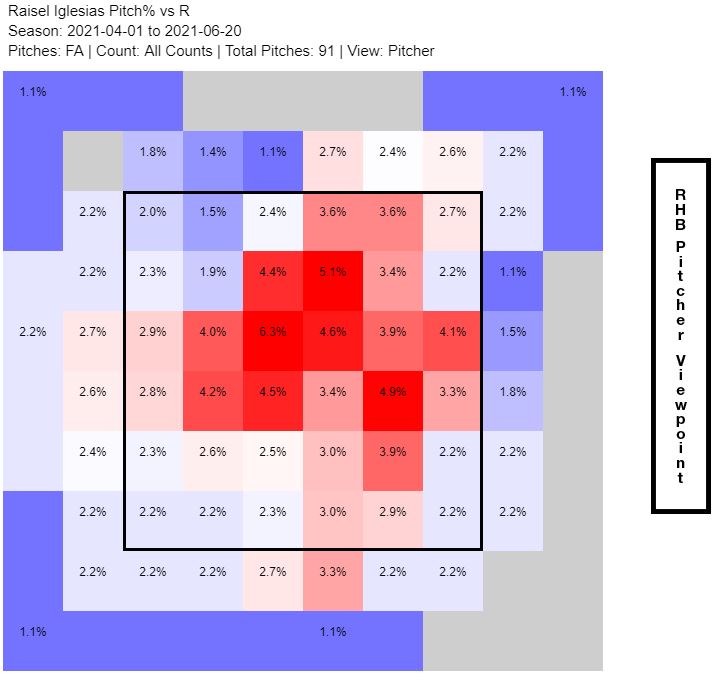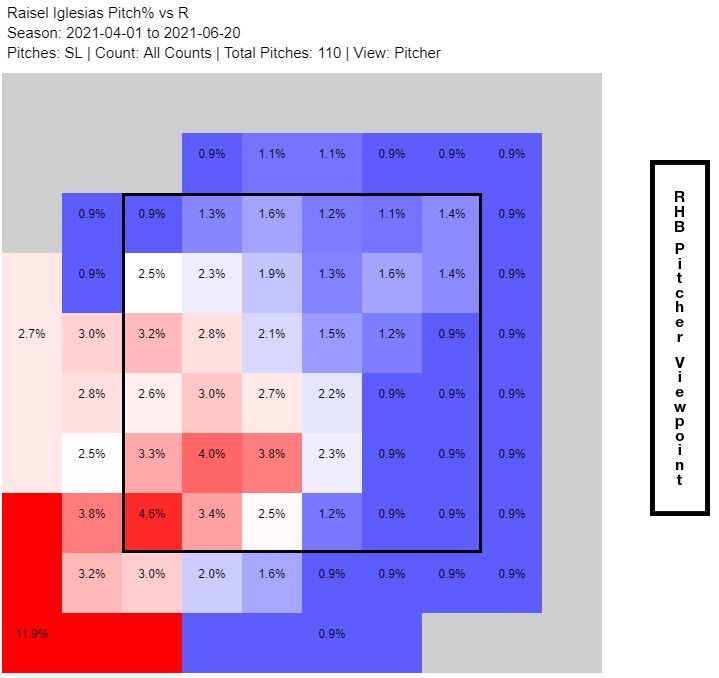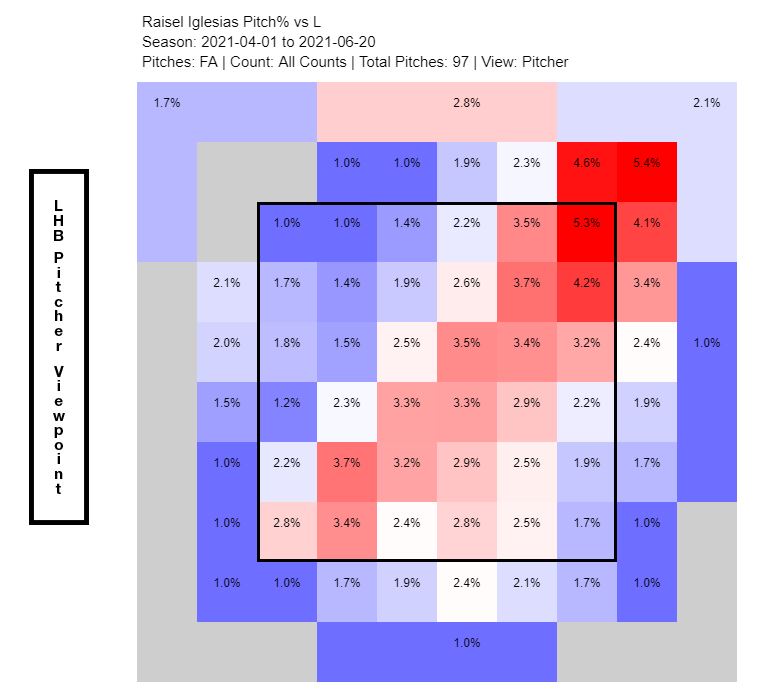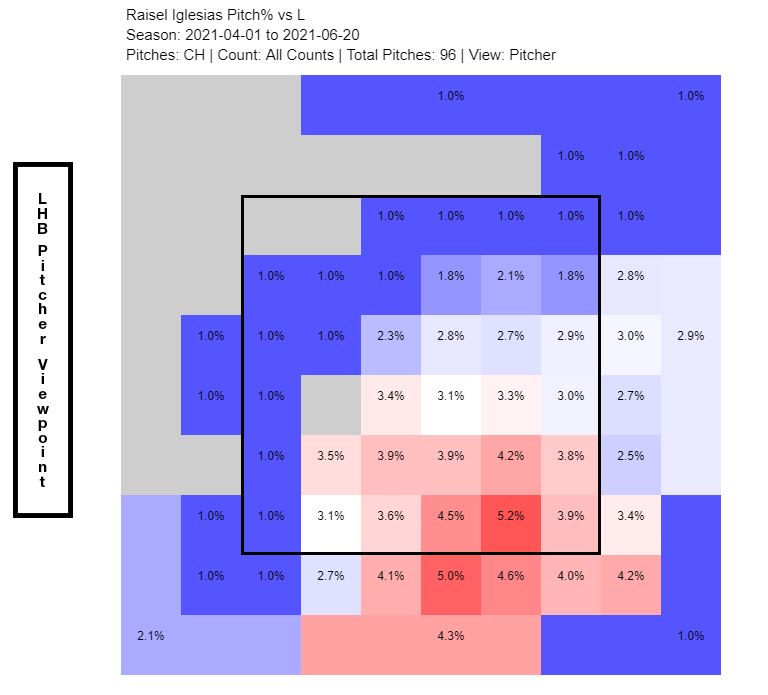Raisel Iglesias, Lefty (and Righty) Specialist
Do you know the pitcher with the highest swinging-strike rate in all of baseball this year? Well, it’s Jacob deGrom, no surprises there; it’s such an obvious answer that I probably didn’t need to ask. But do you know the pitcher with the second-highest swinging-strike rate? It’s Raisel Iglesias, and the Angels’ closer has been impressive so far this season, even if his run prevention numbers don’t quite show it yet.
If I could see only one pitching statistic, I’d choose swinging-strike rate. That’s not to say that nothing else matters; that’s decidedly not the case, and there are easy examples of both pitchers who miss bats but aren’t effective and pitchers who are effective without missing bats. But as a first pass, swinging strikes are great. Everything else is contextual. Called strike? That’s because the batter didn’t swing. Foul? It’s not always worth a strike. Groundball? The batter could hit it through the defense or find a gap. A swing and miss is absolute.
You probably don’t need to hear that. Whiffs have been the premium currency of pitching for a long time, long before we had the pitch-level data to track them accurately. I merely thought I’d mention it, because wow does Iglesias miss a lot of bats.
Most closers operate with a common template. Throw a really good fastball — a really good fastball — and spot an unhittable secondary pitch off of it. It’s not always about velocity, though it often is. But it’s almost always about a fastball and one pitch spotted off of it — a guessing game for the hitter with two bad answers.
Iglesias is that pitcher, kind of. Against righties, he relies on a four-seam fastball and a devastating slider. He mixes in a smattering of two-seamers and changeups, but mostly for show; more than 80% of his pitches are fastballs or sliders. Against lefties, Iglesias also relies on two pitches: his fastball and changeup. He throws each of them roughly 40% of the time, with sinkers and sliders comprising the remainder of his offerings.
Sliders are the pitch of the moment. Pitchers are increasingly throwing them to every hitter they possibly can, regardless of handedness, and getting strikeouts for their troubles. But historically — and even now, despite declining splits — sliders work better when thrown to same-handed batters. Changeups have the opposite effect; they do better against opposite-handed batters, which is why starters use them more often than relievers.
In right-on-right matchups, Iglesias is your standard relief ace. He throws a four-seamer that’s generally up in the zone:

At 96 mph, it’s certainly got the velocity to succeed, but it’s not a true standout; it has more horizontal run than the most devastating bat-missing four-seamers. Really, though, it’s just a setup pitch. When Iglesias gets ahead in the count, it’s time for his mid-80’s slider, and the location of this is pretty much what you’d expect:

Down and out, just like batters’ chances against him.
It’s a cookie-cutter approach, one shared by many high-leverage arms, and quite frankly, it just works. Iglesias is downright sharp with the slider, which is why he’s high on the list of pitchers with the best swinging-strike rates against righties:
| Pitcher | Pitches | SwStr% |
|---|---|---|
| Jacob deGrom | 494 | 25.1% |
| Corbin Burnes | 524 | 24.4% |
| Josh Hader | 345 | 24.1% |
| Cody Stashak | 179 | 23.5% |
| Phil Maton | 289 | 22.1% |
| Devin Williams | 233 | 21.9% |
| Drew Smith | 121 | 21.5% |
| Raisel Iglesias | 257 | 21.4% |
| Victor González | 170 | 20.6% |
| Jimmy Nelson | 210 | 20.0% |
Yeah, that’s pretty good. That’s the point of having an elite reliever: They throw gas and mind-bending sliders, and batters wilt. This isn’t some new skill for Iglesias, though he’s kicked it up a notch this year; his strikeout rate is 13th among pitchers who have thrown at least 15 innings to right-handers. But that wouldn’t be that interesting of a conclusion, would it? A great right-handed reliever is great against right-handed batters; more at eleven.
Fine, I’m not telling you anything new here. But let’s look at a different list: the best swinging-strike rates against lefty batters, again with a minimum of 100 pitches thrown:
| Pitcher | Pitches | SwStr% |
|---|---|---|
| Drew Pomeranz | 103 | 24.3% |
| Liam Hendriks | 252 | 23.4% |
| Raisel Iglesias | 229 | 23.1% |
| Jordan Romano | 166 | 22.9% |
| Taylor Rogers | 169 | 21.9% |
| Will Smith | 129 | 21.7% |
| José Quintana | 176 | 21.6% |
| Ryan Tepera | 159 | 21.4% |
| Jacob deGrom | 466 | 21.0% |
| Craig Kimbrel | 253 | 20.9% |
Meet Raisel Iglesias, lefty killer. He leads off with a four-seam fastball, mostly high and away:

That’s not a pristine heatmap, but you can see his thought process: he’s mainly staying high and away, and when he deviates it’s in a diagonal across the strike zone. He backs that up with a changeup that looks like it will follow the fastball, only for it to drop off the table:

Those gaudy strikeout numbers against righties? Iglesias looks just as good against lefties, and he doesn’t walk many either:
| Year | K% | BB% | K-BB% |
|---|---|---|---|
| 2015 | 16.8% | 7.6% | 9.2% |
| 2016 | 18.2% | 7.8% | 10.4% |
| 2017 | 23.3% | 13.3% | 10.0% |
| 2018 | 22.4% | 7.5% | 15.0% |
| 2019 | 28.2% | 7.7% | 20.5% |
| 2020 | 32.5% | 2.5% | 30.0% |
| 2021 | 33.9% | 3.6% | 30.4% |
How does he manage this trick? His fastball is the perfect complement to both of his secondary pitches, as this Baseball Savant graphic shows:

Righties have to guess between a fastball with spin coming up and in and a slider that looks to move down and away. Khris Davis hasn’t been the most formidable of hitters this year, but that doesn’t mean this pairing is any less effective. First, a fastball in a hitter’s count that sets his eye level:
Next, a slider that looks enticing — hey, this could be a fastball — before fluttering down and away:
The fastball works differently against lefties. There, we aren’t talking about pitches with opposite break, but rather pitches that start out looking similarly before breaking differently. Take a look at another graphic, this one of the actual movement (rather than spin orientation) of his three offerings:

The changeup looks like his fastball out of the hand, but it tails away from lefties rather than riding. That’s how Iglesias pitched to Brandon Lowe — first with a fastball that Lowe got a good hack at but swung under:
And next with a changeup that Lowe read as a fastball and swung over:
Individually, there’s nothing unique about these pitch combinations. That’s just how changeups and sliders play off of fastballs. But only six relievers this year with at least 20 innings under their belt have thrown three pitches at least 25% of the time each:
| Pitcher | FB% | SL% | CB% | CH% |
|---|---|---|---|---|
| Tejay Antone | 32.0% | 34.7% | 33.3% | 0.0% |
| Raisel Iglesias | 42.8% | 28.6% | 0.0% | 28.6% |
| Wandy Peralta | 36.3% | 25.5% | 0.0% | 38.2% |
| Jimmy Nelson | 35.5% | 31.7% | 32.8% | 0.0% |
| Jeffrey Springs | 39.8% | 34.2% | 0.0% | 26.0% |
| Daniel Norris | 40.4% | 29.6% | 0.0% | 30.0% |
In addition to letting him function like two different pitchers — a lefty specialist and a power righty — Iglesias’ repertoire gives him a powerful change of pace. It’s particularly effective against righties, where the name of the game is “avoid sliders.” A batter who doesn’t see slider spin should swing, unless it’s a changeup. But Iglesias uses the pitch just infrequently enough to keep them guessing:
| Pitch | Usage vL | SwStr% vL | Usage vR | SwStr% vR |
|---|---|---|---|---|
| FF | 41.0% | 21.3% | 33.9% | 9.2% |
| SL | 12.7% | 17.2% | 42.4% | 28.4% |
| CH | 42.4% | 26.8% | 17.1% | 34.1% |
The sample sizes on these splits are still small, so don’t take them as set in stone. Over the past four years, his four-seam fastball has similar swinging-strike rates against lefties and righties despite the large discrepancy so far this year. But the general plan works, and it explains why Iglesias sports gaudy strikeout and whiff numbers against everyone.
If his strikeout numbers are so excellent, why hasn’t Iglesias been better this year? It’s the home runs. He’s already given up seven on the year, and while it’s tempting to chalk that up to random variation, I’m hesitant to ignore it.
Though his pitches pair well with each other, none are overwhelming on their own. He’s also developed a bad habit of leaving his fastball over the middle of the plate, particularly to righties. That pitch to Davis might have gotten a take, and Lowe swung through a cookie, but Iglesias wasn’t so lucky against Carlos Correa:
Similarly, he relies on deception to make his changeup work, but the location isn’t always pristine. He sometimes uses a Lucas Giolito favorite — the high changeup — but does a worse job than Giolito at keeping it out of the middle of the zone. Of the seven homers he’s surrendered, three have come on in-zone changeups and two on grooved fastballs.
To some extent, that’s just the Raisel Iglesias experience. When he doesn’t allow home runs, he’s phenomenal, one of the best relievers in baseball. When he does, he’s solid but not great. He probably won’t develop pinpoint command overnight. But it’s okay! He has the approach and arsenal to make that work. Making mistakes is more palatable when you’re starting every at-bat with an advantage, and that’s exactly what Iglesias’s changeup/slider/fastball combination is: an advantage against every batter, whether lefty or righty.
Ben is a writer at FanGraphs. He can be found on Bluesky @benclemens.

He’s a really interesting case. He has had pretty extreme (but normal directionally) FIP splits in his career until 2020. That is to say, he was not very good at all vs. lefties through mid-2019. But for the past three partial seasons, his FIP has been a ton better vs. lefties than righties. Normally small enough sample to ignore, but this article seems to back up the reason for improvement.